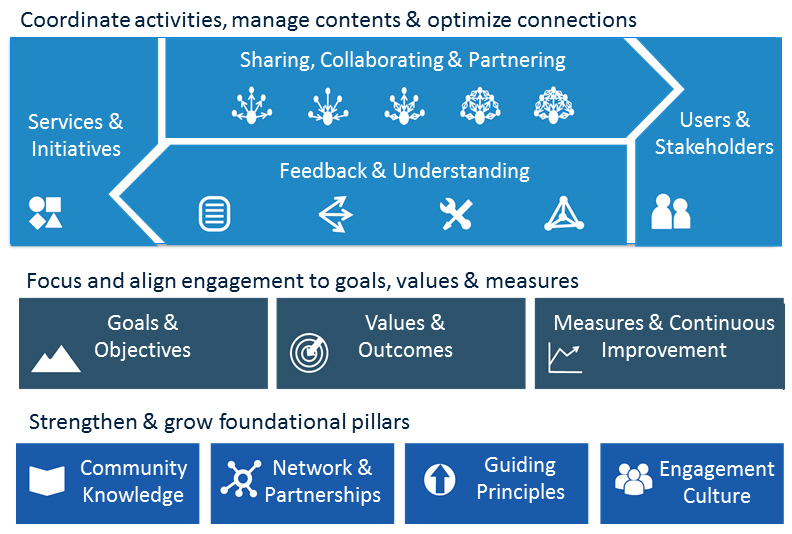
As part of the IT @ UBC Strategic Plan, through Community Engagement we want to:
- Strengthen and grow the Engagement Foundation pillars
- Focus and align our groups goals & objectives to (Engagement) value for the stakeholders for each service and initiative
- Plan and execute engagement with a strategy to coordinate engagement activities, manage contents and optimize connections
1st Level - Engagement Foundation
Know what we have as our basis
- Community Knowledge – This is the knowledge that we have accumulated from our prior engagement with UBC communities, including the stakeholders, interests and vehicles
- Network and Partnership – These are established connections between our community engagement points and how they facilitate our reach and distribution of contents.
- Guiding Principles – These are existing and new principles may be established and clarified to guide the organization.
- Engagement Culture – These are behaviors and expectations that we can hone to build an engagement culture in our IT @ UBC community, applicable for internal and external to UBCIT.
2nd Level – Engagement Value
- Address WHY we engage. What value do the stakeholders and IT @ UBC receive from the engagement.
- Better understand the goals and objectives required for engagement and their derived values and outcomes.
- Determine what and how we want to measure our successes. How we provide the feedback for continuous improvement.
3rd Level – Engagement Strategy
- Services & Initiatives - Understand our services and the initiatives and their outcomes for the end users, whether it is a new service introduction or a large transformation program.
- Users & Stakeholders - Understand who our primary, secondary stakeholders are, their interest and perceived value of the services and initiatives. Who needs to be accountable for delivery within IT @ UBC and the UBC Community.
- Engagement Spectrum – Engagement level determined for each service or initiative and their corresponding stakeholders. Degree of connection and interaction required ranges from information sharing (for awareness), consultation (for feedback), collaboration (for joint teams), and partnership (for co-sponsorships)
- Engagement Strategy – Plan and execute engagement and management of contents, channels and activities required to successfully meet the goals and objectives.